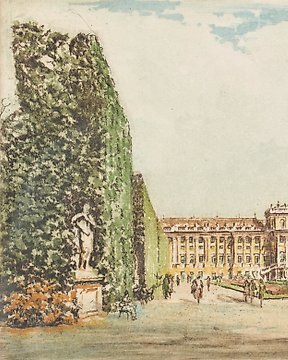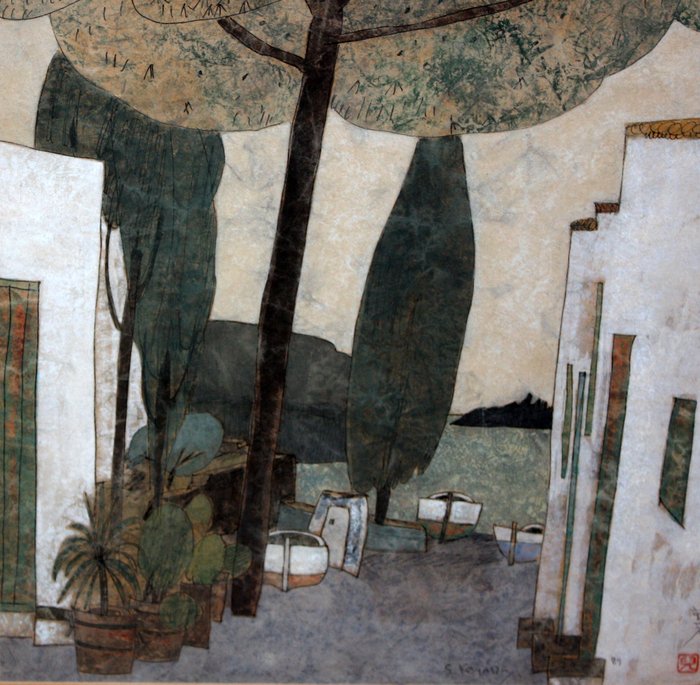
Austrian School (XX) - schloss schönbrunn, Vienna Austria
No. 17936487

No. 17936487

Signed by the artist at the bottom and dated in 1989
The painting is nicely framed.
Dimensions of the painting: 39 cm high x 39 cm wide
Dimensions of the frame: 55 cm high x 55 cm wide
In good condition.
:::::::::::::::::::::::::::::::::::::::::::::::::::::
Biography of Shigeyoshi Koyama (Osaka, Japan, 1940)
Shigeyoshi Koyama was born in Osaka (Japan), in 1940. Twenty-two years later he moved to Tokyo, and shortly after began his career as a painter. In 1970 he made his first trip to Paris, where he spent six months; From there he moves to Cadaques, a town where he will stay until the end of 1982. It is during this period that he makes his first exhibition in his native country, specifically in Tokyo. Years later, he returned to Cadaques, where he finally settled in, the year 86. He has been a painter closely linked to this village from el Emporda since he arrived.
Light, which is like the revealing hand of all that is visible, seems to have provoked the artist. This light is found in his works, painted -precisely- in southern and Mediterranean Europe, places that he seems to have definitely chosen.
But Koyama evidences his oriental tradition in the very conception of the pictorial space: the perspective is not posed from the Renaissance canons, but develops the theme from the resolution of the planes. For this reason, in his works we find a different way of presenting reality: not as the eye perceives it, but as it is interpreted by knowledge and sensitivity.
It works indistinctly the technique of oil and watercolour. His palette moves between blues and greys, but he does not forget the greens and reds, whites and oranges, which he chooses according to the time of day and the season. As the art critic Francesc Galí wrote, it is a chromatic fan that serves to compose a painting -inseparable from the drawing- that gives rise to a combination, simple and wise, of spots (...) that stand out and differentiate the calligraphies (...) that complement the plastic descriptions that he argues.
Koyama is still what he was in his origins: a painter who, from specific referents, creates environments, worlds, timeless universes, which he places in Cadaques, but also in Barcelona, Paris, La Mancha, Albarracin, Sicily ... And it is this real and imaginary artist, oriental and western, figurative and abstract, the author that some critics have called the Koyama style, which is still a refined and consistent way of perceiving the world.
The collective sense in the work of Koyama
by Josep M. Cadena (journalist and art critic)
The Cadaques painted by Koyama is personal. The same goes for his visions of Sicily, which he also shows us in this exhibition. And in a similar way -even identical- we could talk about the works he has dedicated to different places in Spain and Europe that he has visited and where he has resided for some seasons. But, at the same time, in everything for which he feels artistic interest, there is a participatory sense in which all of us who believe in art as a means of expressing the best human qualities know how to find ourselves.
And it is because Shigeyoshi Koyama, born in Osaka the year 1940, is a creative plastic with universal expressive force regarding feelings. Japanese by birth and culture, has never been in the superficiality of the forms but has been successful in interpreting, according to the fundamental principles of their culture, the common characteristics that exist among humans, wherever they are and wherever they go.
Particularly I think that Koyama has found in Cadaques - not the “cap de quers”, of stones and rocks, as it is usually thought of, but the harbour or bay where to anchor when the Mediterranean threatens temporally, according to the suggestive philological interpretation of Joan Coromines, extracted from the Greek and, specifically, of the history of
Thucydides - the shelter that reminds him of the first impressions, those on which the personality of people and their ways of expressing themselves are based. Because everything is different when we see it for the first time and we do not stop to analyse it, but everything is the same or very similar when we look for the essences. And given that, Koyama has chosen this second way, the most authentic and the most difficult at the same time, to find himself in a state of vital purity, according to the sensations of childhood, he also connects very easily with the children that we all still carry, fortunately, inside us.
Koyama’s figuration represent geographical locations, but always according to vital states. He knows how to look and never paints what he sees, but what he feels. That is why in his paintings there is always a schematic sense imbued with emotional naivety, which leads us to love the concept above forms. These exist, but they are like the words written in a poem, which, when read according to their primitive meaning, lead us to make with our own feelings an act of collective understanding.
How to buy on Catawiki
1. Discover something special
2. Place the top bid
3. Make a secure payment